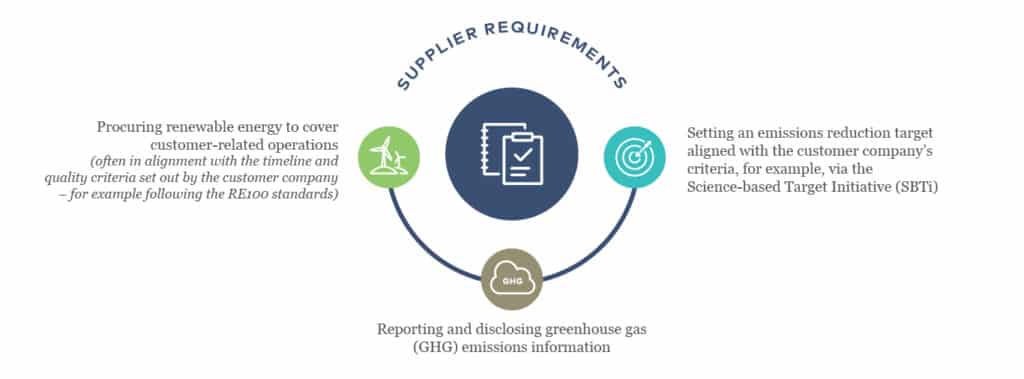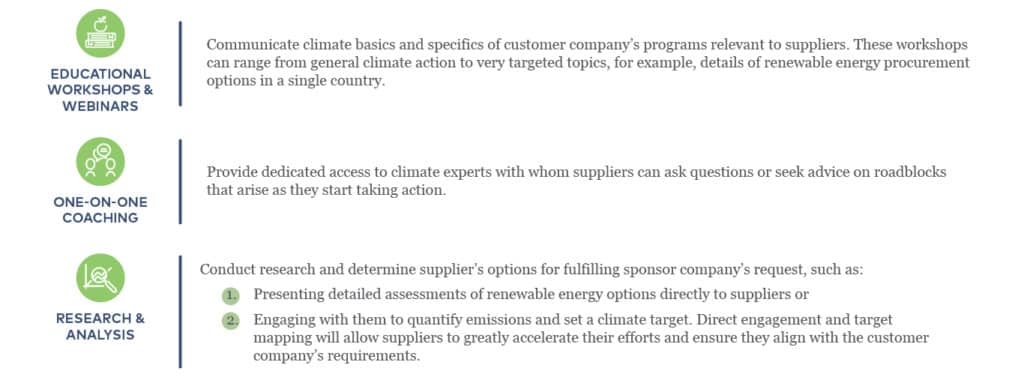One of the more difficult places to make meaningful reductions is in scope 3, not just because of its size, but also due in part to the emissions falling outside of an organization’s direct control. However, organizations that collaborate with their suppliers will be in a stronger position to implement successful value chain interventions and achieve their climate goals. Additionally, well-executed supplier coaching programs result in the company’s messages and requirements being amplified to suppliers, suppliers having greater success in taking action, and strengthened customer-supplier relationships.
To get there, companies need to first understand the common strategies for engaging suppliers and then dedicate resources to these efforts, while avoiding common pitfalls of supplier engagement. Creating and launching a supplier program is no easy task, but we’ll walk you through why it is impactful and how to get started.
THE NECESSITY OF SUPPLIER ENGAGEMENT
Many companies have set climate targets that they alone cannot achieve; they will need their suppliers to act in order to reduce their value chain emissions.
Companies are continuing to set climate targets at accelerated rates. Climate targets require companies to not only reduce their own operational emissions (scopes 1 and 2), but also to reduce emissions in their value chain (scope 3). Value chain emissions often make up a large portion of a company’s footprint, yet they can be the most challenging to measure and reduce. These value chain emissions are outside the company’s direct control and require action by upstream and downstream suppliers – in fact, scope 3 emissions accounting and targets are designed to promote this type of action.
Companies with climate goals that extend to their value chain are realizing that supplier action is a key factor for success.
It is, therefore, not uncommon that when companies outline a plan to meet their goals, they also define requirements for how their suppliers must contribute. With these requirements asserted, companies begin engaging directly with suppliers on the topic of climate action. Requirements can be communicated in many ways, from updated supplier contracts or codes of conduct to surveys and requests for data via various platforms. Common requests of suppliers include:
- Reporting and disclosing greenhouse gas (GHG) emissions information
- Setting an emissions reduction target aligned with the customer company’s criteria, for example, via the Science-based Target Initiative (SBTi)
- Procuring renewable energy to cover customer-related operations (often in alignment with the timeline and quality criteria set out by the customer company – for example following the RE100 standards)
Along with the requirements, companies must determine how they will motivate suppliers to participate in the program. Companies will decide what incentives (“carrots”) will be used to motivate suppliers to act, what mechanisms will be used to reward good work, and if there will be any repercussions for non-compliance to requirements (“sticks”). For example, companies requesting supplier action could reward supplier participation with public recognition or more favorable contract terms, or employ a consequence for non-compliance, like canceling the contract. Companies also need to prioritize what suppliers to include in their supplier programs. Effective supplier engagement programs are typically geared toward suppliers with a high emissions impact or those that make up a sizable portion of the company’s spend.
Once these requests reach suppliers, regardless of where they are on their own climate journeys, suppliers often look to the company making the request for support in taking action.
Outside support and expertise is commonly needed for any company (both suppliers and reporting companies) to meet these requests. Sometimes suppliers need basic support, such as an introduction to the climate action landscape; other times suppliers need more intensive support, such as when purchasing renewable energy. At this point, suppliers may not know that support is available to them. Therefore, oftentimes we see vendors not responding at all to requests or submitting incomplete data rather than asking questions to help fulfill the request.
In the case where companies need suppliers to take action and have resources to dedicate to these efforts, providing direct support to suppliers is often an effective choice.
Some companies choose to dedicate teams to engaging directly with suppliers. However, many companies don’t have the internal resources (namely staff or expertise) to manage supplier questions or provide direct one-on-one support but do recognize that dedicating resources or budget toward value chain emission reductions is critical to achieving their goals and choose to work with outside climate experts.
GETTING STARTED WITH A SUPPLIER PROGRAM
Supplier coaching can be provided across various topics, from GHG measurement and reporting, to target setting and emission reduction planning, to renewable energy procurement. The support provided will look different for every supplier, as it’s important to ensure it’s tailored to meet the individual needs of suppliers. Common methods of support for suppliers include:
- Educational workshops & webinars – communicate climate basics and specifics of customer company’s programs relevant to suppliers. These workshops can range from general climate action to very targeted topics, for example, details of renewable energy procurement options in a single country.
- One-on-one coaching – provide dedicated access to climate experts with whom suppliers can ask questions or seek advice on roadblocks that arise as they start taking action.
- Research & analysis – conduct research and determine supplier’s options for fulfilling sponsor company’s request, such as:
- Presenting detailed assessments of renewable energy options directly to suppliers or
- Engaging with them to quantify emissions and set a climate target. Direct engagement and target mapping will allow suppliers to greatly accelerate their efforts and ensure they align with the customer company’s requirements.
With a supplier program, you have to meet suppliers where they are and provide decision-useful, actionable support. With cost being a primary consideration for many companies, ensure it is taken into account in all materials. Be respectful of the level of time and expertise suppliers can dedicate to each effort and ensure all requests are streamlined. Finally, empathize with common roadblocks like data limitations, confidentiality concerns, and internal buy-in in order to provide realistic solutions that translate to results. These results – including emissions reductions, improved measurement, cost savings, etc. – mutually benefit the customer company and the supplier.
Overall, through supplier coaching engagements, companies are able to support their suppliers in taking action while ensuring their investment in reducing value chain emissions is effective.
3Degrees can provide direct support to a company’s suppliers on their behalf, allowing companies to focus on their own internal initiatives while providing suppliers with the highest level of expert support. Please get in touch with us if you are interested in learning more about our supplier coaching services.



